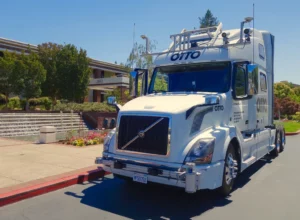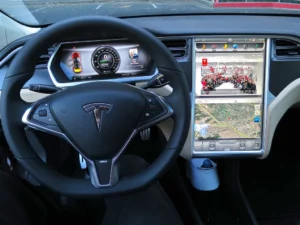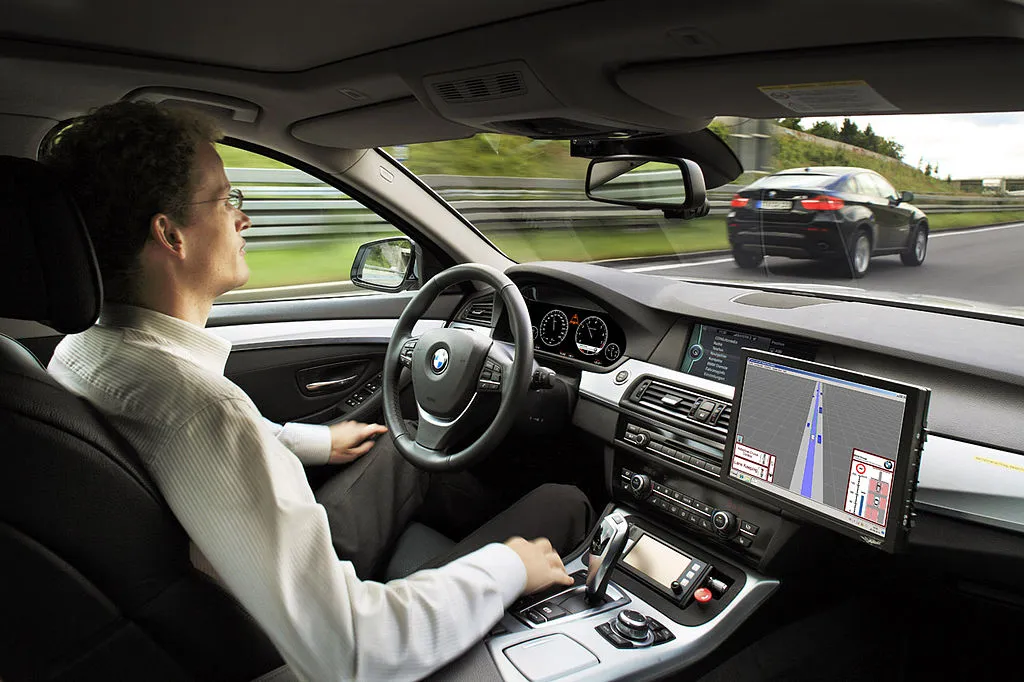Autonomous vehicles¹ have made significant inroads over the last few years. You would not need a crystal ball to guess there will soon be one in a garage near you. They may not even need one! Critics and cynics may raise concerns, and indeed, a few accidents have happened recently, but the statistics show that autonomous vehicles already drive much safer than humans. As the percentage of self-driving cars increases, the track record will improve. The US Department of Transportation aims to eliminate all fatal car accidents in the US 30 years from now.
What can we expect?
This article outlines the opportunities, risks, and reasons why the process may take slightly longer than some optimists claim. Fully autonomous vehicles will ultimately change our society, and we need to be ready for what may happen over the coming years and jointly shape our future.
Levels of self-driving

It may take ten years until fully autonomous cars are on our roads. On the other hand, such vehicles may be the most common. However, cars with increasing degrees of automation will become the standard much before that. Indeed, the development of self-driving cars with increasing levels of automation is already well underway.
Levels of automation
SAE International has defined six levels of autonomous driving.
- Level 0 – No automation
- Level 1 – Driver Assistance: Cruise control, lane guidance and automated parallel parking. The driver is still fully engaged in all operations.
- Level 2 – Partial Automation: Adaptive cruise control with lane centring. The driver is still responsible for monitoring and should be available to take control at any time but may not need to touch the steering wheel or pedals.
- Level 3 – Conditional Automation: Drivers can cede all safety-critical functions under certain conditions. The driver is not expected to check the roadway. However, the car may ask the driver to take over under some circumstances. At this level, the driver can work while travelling on a motorway. The reaction time for a human to take over would be significant compared to the level 2 scenarios. This takeover time is a reason which speaks against this level of automation. Car manufacturers may have to skip this level and move directly to Level 4.
- Level 4—High Automation: This is a fully automated driving system in which the car manages all aspects of the driving, even if the human driver does not respond appropriately to a request to intervene. At this level, the driver can work in most conditions and perhaps even sleep on a motorway.
- Level 5—Full Automation: This vehicle is fully automated and can manage all aspects of driving on any road and under any environmental conditions without human intervention. Cars capable of Level 5 automation are likely to be available by 2030.
Autonomous cars are safe.

Eighty-five thousand people die on the road every year in Europe. In the world, the figure is about 1.25 million. In other words, more than two people die on the road every minute. Forecasts say that within 30 years, self-driven cars will cut that figure by 90%.
Recent accident
In May 2016, a new self-driving Tesla car collided with a tractor-trailer at an intersection on a highway in Florida. The driver of the Tesla died. However, the U.S. National Highway Traffic Safety Administration found no fault in the Tesla Autosteer technology. Instead, it found that Tesla cars were 40% less likely to crash when driving in self-driving mode than when not. However, Tesla would immediately improve its autopilot system by sending a software update to all cars. The next time a similar situation happens, any Tesla car will be able to manage the situation and avoid the accident. Unlike the case for human drivers, self-driven cars can learn all the time and share knowledge across the entire fleet of Tesla cars. By 2050, self-driving vehicles can save as many as 30 thousand lives yearly.
Wild animals
Between 45 and 60 thousand wild animal accidents are reported yearly in Sweden. Human drivers find it hard to see approaching animals, especially in the twilight. In most of these accidents, only animals are injured, and the vehicle may be damaged. Human injuries are as low as about 800 per year, and there are less than ten fatal accidents per year. Volvo Cars in Sweden are developing technology to find out when wild animals are about to cross the road and avoid accidents. Volvo claims that by 2020 nobody will be killed or seriously injured in a new Volvo.
Reaction time
We can assume that an autonomous vehicle can assess a situation in about 0.3 seconds. Humans, however, may have a reaction time of two seconds. Assume that two cars drive 90 km/hr, of which one is autonomous, and the other has a human driver. Given the reaction times above, the autonomous vehicle would apply breaks or divert after only 7.5 meters against 50 meters for the human driver. Autonomous vehicles would also better consider other vehicles and be far better at avoiding cars driven by human drivers. In this way, autonomous vehicles can save lives. Note that this is possible even with Level 2-3 automation.
Autonomous transportation

Autonomous cars such as Tesla, BMW, Mercedes and Volvo will have their early adopters, especially in the luxury segment. However, the commercial gain may not be in self-driven private cars but autonomous trucks and buses. Here are some reasons why we can expect transportation companies to adopt autonomous vehicles:
- Salary costs
- Ability to run 24×7
- Labour legislation
- Fewer accidents
- Less risk of theft of goods
Long-haul drivers tend to work long working weeks, and fatigue is one likely reason for accidents. Technology is already around. Initially, transport companies may aim to reduce the number of drivers to one per vehicle and, in due time, entirely remove the drivers. To give an idea of the scale of this impact – There are about 13 million heavy-duty vehicles and 23 million light-commercial vehicles in Europe.
New visions for transportation
There are different views on how future transport will develop. Will small vehicles transport goods directly from production to their destination, or will large trucks still be used for long-distance transport?
There will likely not be one solution, and combined with new production methods (Automation, 3D printing, etc.), we can expect other changes to the requirements for future transport as well. Since most manufacturing may move closer to where the consumers live, smaller autonomous vehicles (or even drones!) may make more sense than larger vehicles. On the other hand, where long-haul transport is required, larger automated trucks between hubs may make more sense from an economic and environmental perspective.
What speaks for implementing automation
There is a lot which speaks for this transformation;
- Reduced number of accidents
- Remove or at least reduce the risk of fatal accidents
- Ability to work in the car
- More people can share a car since the car does not need a driver to move between places.
- Car sharing pools
- The company provided shared vehicles on demand (Such as Uber)
- Reduced cost of transport due to no need for drivers
- Environmental gains due to more optimal driving techniques
Social impact
This transformation will, however, have significant social impacts on society. Some of these changes may be good, but others may, if not mitigated, create hugely adverse societal effects. Many drivers will likely lose their jobs. Truck driver is the most common profession in many US states; millions will lose their jobs over time. This change will take years, and not all trucks will be replaced immediately. Some current drivers may retire before they are made redundant by an autonomous vehicle. But it makes sense to assume that within 20 years, all long-haul trucks will be fully independent.
What can delay autonomous cars?
The opportunities are enormous, so when will this revolution take place? Some factors can delay or affect the roll-out of autonomous vehicles. The main ones are probably regulation and compliance, improving Human-Machine Interaction, getting people to trust the cars, and ensuring that vehicles can manage extreme road and weather conditions.
Policy and regulation
 mentioned above was such a case.
mentioned above was such a case.
Policymakers may be hesitant to implement new legislation, and such delays may slow the rollout of autonomous cars. At the same time, given the dramatic impact on road safety, it is safe to assume that driver assistance will become mandatory. In the US, all cars must have automatic breaking facilities from 2022.
Insurance and Liability
Even though accidents will be less familiar with autonomous vehicles, insurance companies may argue whose fault an accident is. However, car manufacturers will take full responsibility if the car is autonomous. Hence, this is not likely to be a significant obstacle. German authorities have already started the work to define ethical rules for autonomous vehicles. They explain how prioritising human lives, animals, and other things should be done in a potential accident scenario. This is not something human drivers usually think about. This may be a policy issue but is closely connected with liability.
Privacy issues
Since autonomous cars use navigation equipment and communicate with servers and possibly even other vehicles, data about where each person’s car is located would be collected in real-time. Car manufacturers could then track and predict standard routes for each person. Government agencies and companies may use such information to track or monitor cars, advertise them, and market them.
However, this information is already known since most of us use smartphones. Telecom operators can also, obviously not with the same precision, track in which area we are. Tracking cars may not make a significant difference. Governments and Corporations can always potentially use and misuse collected information. It is possible to anonymise data and implement regulations and compulsory privacy audits. However, tracking autonomous vehicles is only one more risk.
Security

If autonomous cars are connected to the Internet, there are risks that they can be hacked. Hacking may be done to find where certain people or vehicles are, but rogue hackers could also take over one or many cars. Potentially high-tech terrorists can threaten civil society in novel ways. Vehicle manufacturers must ensure that communication is secure and that various protective systems are implemented to track unexpected deviations and react to suspicious situations.
Such solutions are already available in general IT systems. However, there is always a risk unless the software of all included devices is kept up to date. As the vehicle park ages, manufacturers may stop supporting old versions. Therefore, the lifetime of an autonomous vehicle may be shorter than that of a traditional car. This is similar to when Microsoft stopped supporting old operating systems.
How will society change?
IHS forecasts that 76 million autonomous vehicles will be sold over the next 20 years, about the same number of cars sold worldwide in 2016. That may not sound impressive, but since one autonomous vehicle can potentially replace nine owner-driven cars, the figures may imply a far more radical transformation than the statistics indicate. How will our society change as a result?
Our arterial roads are becoming increasingly congested. Instead of constantly adding more flyovers and widening the roads, autonomous cars can drive closer together, allowing us to fit more vehicles into the same space than human drivers.
Cars with automation levels 1-4 are, for all practical purposes, nothing but an incremental improvement of existing owner-driven cars. However, levels 3-4 would still mean that the driver can work during some or all parts of the trip, but there is still a need for a person with a driving license. Only cars with level 5 imply a fully self-driven car. All automation levels will make driving safer, but only level 5 will be truly transformational. For level 5 cars, there may not be any need for a steering wheel or pedals or a person with a driving license.
Predictions
We can only be sure that all our predictions will be wrong (including this one). The emergence of self-driving cars is already well underway, and we can reasonably predict their development by extrapolating today’s development. However, while technical capabilities can be predicted easily, changes in social patterns and business models are more complex.
Most new cars will likely be fully autonomous driving in ten years. However, since the average lifespan of a car is 20-25 years, it will take almost 20 years until the full effect of this change is experienced. Governments must consider what to do since many people may lose their jobs due to increased automation. Stopping technical development is likely not to be a relevant way. Elon Musk, the founder of Tesla, SpaceX and Hyperloop, suggests universal basic income as one possible solution.
New patterns of transportation
Since autonomous cars can run 24×7 vehicles, it would be a wasted opportunity to keep an autonomous car unused when it could be used. Therefore, it can be predicted that other business models than traditional ownership will emerge. Self-driving vehicles may be near-distance public transportation tomorrow.
This will change in the following steps: Initially, self-driven cars will probably be owned by people, exactly as today’s cars. However, the number of cars required would decrease when self-driven vehicles can be used around the clock. Welcome to Car-as-a-Service – CaaS! Manufacturers Uber and Lyft already plan for such solutions!
Autonomous taxis
Imagine a perfectly AI-driven, optimised taxi system without drivers. Such a method would compete with some traditional public transportation, particularly slow, inefficient types such as buses and trams. Existing underground systems, especially in larger cities, may be able to retain their position initially.
Over time, fully autonomous vehicles will replace traditional owner-driven cars, and congestion will likely be reduced. Autonomous vehicles working with coordinated AI systems will reduce delays and congestion in the long run. Thanks to this, we may change how we build cities unless the node-based public transportation system is no longer the primary factor for where buildings and offices are built. Such societal changes may even, in the long run, reduce the need for the underground. Ultimately, fully automated cars may be the only required public transportation system.
Longer range travel
For long-range travel, some node-based, high-speed new technologies, such as HyperLoop, may replace trains and flights, especially on high-volume corridors between larger cities. However, Airbus and Siemens plan to develop a small electric aircraft with less than 20 seats for short-range transportation.
It does not take much imagination to predict that these may become autonomous and may not even need an airport. Environmental objectives will be a significant driver, but since the gains would not be limited to the environment but could generate substantial benefits in the form of less congestion and shorter and more convenient travel time, this will likely be driven sooner or later by other objectives. The fundamental transformation will take place when autonomous vehicles reach automation level 5. However, then we can expect massive changes to our entire society. Before that, automation will support humans and make road travel safer and more environment-friendly.
Moving away from the need for a hub-based local transportation system will have far-reaching consequences for how our societies will be organised. A city centre will not necessarily be required. Will we perhaps prefer to live in villages again? Nobody knows. We can expect a massive revolution, and many questions remain unanswered today.
Conclusions

The next few years will be fascinating. Many manufacturers are about to introduce new self-driven cars; legislation will likely be implemented in more countries. We are likely to see an explosion in the coming years. There are still a few obstacles on the horizon. Some are relatively quickly resolved, while others may be more challenging. In particular, the social issues of people losing their jobs are concerning.
Some countries may hesitate to implement the required new legislation. However, fewer accidents, commercial gains, and increased comfort will ultimately make it happen. New business models will likely emerge in which cars are no longer a product but a service. How will this change our society? Where and how will we live, work, and interact?
Will humans be allowed to drive cars in the future?
We are at the edge of a revolution on par with the industrial revolution, and nobody knows what will happen. Road safety will improve even with lower levels of automation, but what will happen next remains unclear. Maybe the question of when autonomous cars will take over is wrong. Perhaps we should ask ourselves when humans will no longer be allowed to drive cars.
Mikael Gislén is the Managing Director of Gislen Software, a Swedish-owned Indian Software development company. Mikael started the company in 1994. Gislen Software provides high-value software development services to Scandinavian, UK and US clients.
